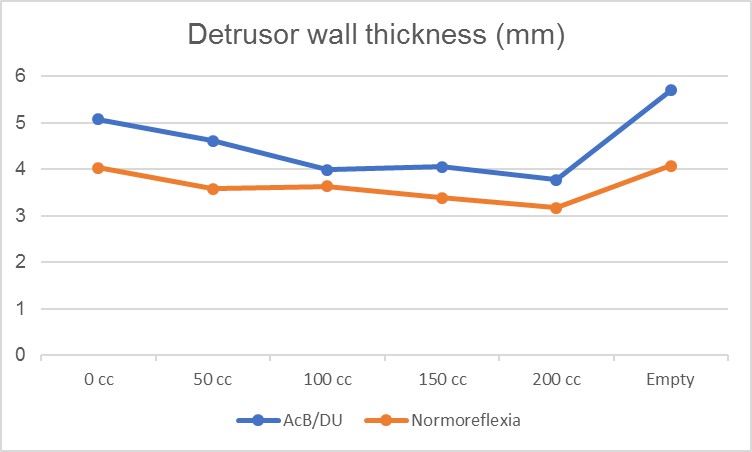以經陰道超音波彈性影像測量逼尿肌功能低下女性病患膀胱逼尿肌組織硬度
初步研究報告
瞿琤1、林志杰1,2、王信凱3 、黃志賢1,2、林登龍1,2
臺北榮民總醫院 泌尿部1;國立陽明大學醫學院泌尿學科及書田泌尿科學研究中心2
臺北榮民總醫院 放射線部3;
Transvaginal ultrasound shear wave elastography to evaluate detrusor wall of acontractile bladder (AcB)/detrusor underactivity (DU) in women:
a preliminary report
Cheng Chu1, Chih-Chieh Lin1,2, Hsin-Kai Wang3, William J. Huang1,2, Alex T.L. Lin1,2
Department of Urology, Taipei Veterans General Hospital1
Department of Urology, School of Medicine and Shu-Tien Urological Research Center,
National Yang-Ming University, Taipei, Taiwan2
Department of Radiology, Taipei Veterans General Hospital3
Purpose:
Acontractile bladder (AcB)/detrusor underactivity (DU) were urodynamic-based diagnosis with similar pathologenic mechanism but different clinical presentations. They share common pathophysiology with myogenic changes related to ischemia, which lead to bladder detrusor wall fibrosis and loss of detrusor muscle contractility. The aim of this study was to investigate the correlation between the thickness and stiffness (measured by shear wave velocity, SWE) of detrusor muscle, both measured by transvaginal ultrasonography, in women with acontractile bladder (AcB)/detrusor underactivity (DU) under different degree of bladder filling.
Materials and Methods:
During the period from October of 2019 to March of 2020, 14 patents were enrolled in this prospective study. According to urodynamic results, 7 women were classified as AcB/DU and remaining 7 women were classified as detrusor normoreflexia. Transvaginal ultrasound were performed by using an ultrasound machine (Aplio i-Series A800, Canon Medical System) with a transcavitary curvilinear probe (3 to 11 mHz) equipped with SWE. Detrusor wall thickness (DWT) and SWE of posterior bladder wall were acquired sequentially starting from empty bladder, different degree of bladder filling (50ml, 100ml, 150ml, 200ml), and once again empty bladder. Pearson correlation coefficients were applied to evaluate the relationship between shear wave modulus and DWT in both AcB/DU and detrusor normoreflexia. An independent t-test was used for comparing two groups under different bladder volume. Two-tailed p value of less than 0.05 was considered statistically significant.
Results:
The mean age was 76.4±9.1 years old for patients with AcB/DU, 67.0±12.9 years old for patients with detrusor normoreflexia. DWT decreases during the bladder filling, and no statistical difference was found between AcB/DU and normoreflexia (Fig 1). Patients with AcB/DU showed significantly greater mean shear wave modulus than those with detrusor normoreflexia under distended bladder (at 100cc, 150cc and 200cc). The AcB/DU group also showed positive correlation between increased mean shear wave modulus and increased DWT at initial empty bladder (r=0.500, p=0.015), 150cc (r=0.716, p =0.001), 200cc (r=0.737, p =0.000) and second-time empty bladder (after distention) (r=0.397, p=0.033). We also observed, although not statistically significant, a trend of negative correlation between DWT and stiffness in women with detrusor normoreflexia under distended bladder (at 150cc, r= - 0.196, p=0.466; at 200cc, r= -0.181, p=0.472).
Conclusion:
Both mean DWT of AcB/DU and detrusor normoreflexia became thinner under bladder distention. AcB/DU women had significant increase in detrusor stiffness under bladder distention. Even under thinner detrusor, there is a positive correlation between DWT and stiffness in women with AcB/DU. This finding may be explained by fibrotic changes of detrusor muscle that resulted in AcB/DU. In summary, shear wave elastography is a feasible and reliable tool for predicting AcB/DU.
Fig 1.

附件: